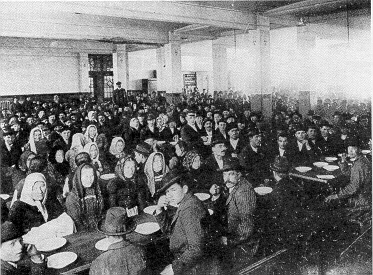




Another reason why German immigrants never formed a solid ethnic bloc
in the United States
was that they crossed the Atlantic with different interests and
expectations. Also, their financial
means varied from the large land owner, for example, who had sold his
home and farm in
Württemberg and had already commissioned someone to purchase land
for him in Wisconsin
before leaving, right down to the penniless farm hand who could not pay
passage for himself and
his family and thus had to mortgage his future.

To finance their passage, many of the penniless before 1820 became "indentured servants," also known as "redemptioners." The typical indentured service contract made out with the captain of a ship provided that the fare had to be paid together with an additional 12% premium no later than fourteen days after arrival. If a passenger was not able to wipe out the debt -- perhaps with help from a relative or a friend in America -- then the captain was at liberty to "sell" the passenger into a form of servitude, often together with his wife and children, for three to four years. Estimates suggest that half of all early German immigrants financed their passage in this manner. To be sure, only non-German harbors, in particular Rotterdam and Amsterdam, permitted this manner of passage. Shippers in Hamburg and Bremen demanded cash payment.
Really profiting from this kind of contract work were the employers
who in the year 1800
paid "bail" amounts of about $70 for a healthy adult in return for three
years of hard work. Under
normal circumstances the owner could realize a profit of between $500 and
$900 from his
purchase. A "serve," as these workers were known in German-American
conversation, worked
for about six cents per day while a "free" day laborer, who likewise
enjoyed complimentary meals
and lodging, earned between 50 cents and one dollar per day. A casual
observer of 1823 points
out the possibility for abuse:
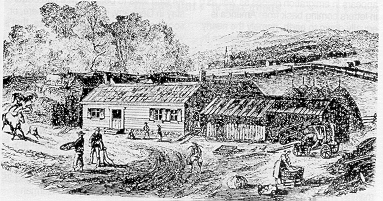
The situation is unbelievably difficult for those people who did not pre-pay their own freight. They almost always fall into the hands of unscrupulous men. Usually only such a farmer would buy a serve [that's how the people are called who have to work to pay back their passage] who could not get any hired hands, for the simple reason that he did not treat them right. He exploits his serve miserably in order to earn back the passage costs in the shortest possible time. Once it has been earned back and the fellow leaves, nothing is lost. Often a serve is beaten like a slave [Johannes Schweizer, Reise nach Nordamerika. Leipzig: 1823,115].
Also comparable to slavery was the regulation that the indentured
servant could be assigned
to another master; family members often became separated from each other,
even forcing children
to be separated from their parents. It was not uncommon to read
advertisements in the
newspapers with descriptions of serves who had escaped, usually offering
a reward for their
recapture.
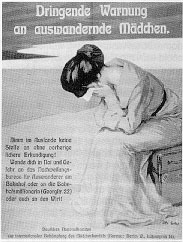
On the other hand, emigration advisers also pointed out the positive sides of indentured status. Those families who initially worked as indentured servants acclimated more rapidly to their surroundings. They picked up the language more readily, got acquainted with American farming methods, learned the techniques of craftsmen, as well as about commerce and the law. As a matter of fact, new arrivals were sometimes advised to volunteer for indentured service as a means to eventually increase their starting capital. Eventually, a federal law of 1855 forbidding contract labor immigration would have put an end to indentured service, had it not been abandoned for all practical purposes in the 1820s due to economic developments.
The dream of most German immigrants in the 18th and 19th centuries was
the debt-free
ownership of a farm. Taking up city residence initially often was a
strategy to build up savings of
$50 to $150. Around 1850 in Missouri this sum was sufficient for a down
payment on a farm of
about 40 acres, which was about the size needed to make a living. In
addition, the immigrant
needed about $500 to acquire implements, cattle and seed grains, as well
as food that would last
until the first harvest. The minimal chattel needed to be able to start a
family farm on the western
prairies around 1870 was a team of horses, a plow and other field
implements as well as seed
grain, which together cost about $1,200. That was more than the average
annual income of a
factory worker.
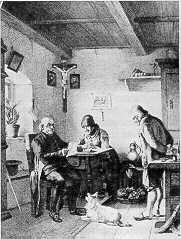
By comparison, German farmers were far more attached to their farms than others, succumbing less frequently to speculative fever. Instead, they tried to buy up land in their own vicinity for their siblings and children in order to be able to farm together for several generations. In 1868, a German farmer in Missouri described the opposite attitude, for which he had little sympathy:
There are people here who are forever moving around. They buy themselves a piece of land, live on it a while, work like a dog, and then, when they do not end up rich in a few short years, they curse the area, sell everything for a song, and move on to spots where they finish up worse off than when they left. Sometimes they return and would be delighted if only they could buy back their original land. In this way they frequently move five or six times before they finally come to their senses and admit that wealth does not fly into every mouth that opens [Kamphoefner, News, 168].
As a matter of fact, the persistency of Germans in certain regions of Wisconsin, the Dakotas, Minnesota, Illinois, Missouri, Indiana and Texas resulted in German islands that have lasted well into the 20tH century, at least in the sense of German conservative-rural, family-oriented values and memories.
If we categorize them by occupation, the largest group of German
immigrants in any given
period were those in the skilled crafts. Upon their arrival in Chicago in
1875, for example, one
third of the Germans were registered as skilled craftsmen, a quarter of
them as common laborers,
and another quarter as farmers. Both in urban and rural settings,
Germans held an equally high
profile as businessmen and shopkeepers, and in the final third of the
century also as skilled
laborers. Some fields of work were filled almost exclusively by Germans,
for example, brewers,
watchmakers, distillery workers and land surveyors. They supplied a large
proportion of the
bakers and butchers, cabinet makers and blacksmiths, tailors and flour
millers, stone masons and
tinners, cigar makers, shoe makers, typesetters and printers. Well paid
indeed were mechanics,
plumbers, and plasterers.
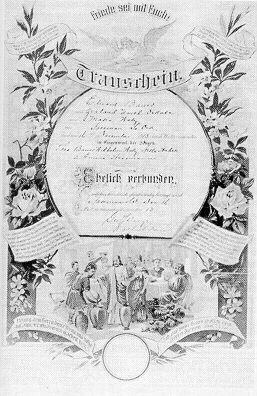
Especially in high demand in the category of unskilled workers, and continuing through all periods of immigration, were domestic servants -- young women who could earn more working in an English-speaking home than in a German-language household of their fellow countrymen. Potential emigrants from certain other occupational categories were well advised not to leave Germany, for they were not in demand. For example, an emigrant guidebook of 1859 admonishes caustically but certainly not erroneously, "a sloppy student would end up a fanatic Methodist preacher; a discarded lieutenant would end up splitting wood or boiling soap; a proud Baron would end up driving a team of oxen; a Catholic priest might end up with a wife and child, happily farming; but a clever stable hand is now in charge of one of the largest business places in St. Louis" [Friedrich Munch, Der Staat Missouri, 1859, quoted by Görisch (1990), 267]. Another guidebook in the 1890s warned that, "those who should under no circumstances even consider emigration include clerks, school teachers, writers, scholars, preachers, telegraph operators, civil servants, students and military officers, even if they have to continue working under the most unfavorable conditions in Germany. For this class of people there are no opportunities whatsoever in America" [Görisch (1990), 203].
Another pointer that frequently appears in emigration guides as well as in letters coming back from America is equally down to earth, namely the nearly unrestricted right to conduct business in America, which was unheard of in Germany. This economic freedom called for both geographical and occupational mobility. Thus in 1868 a successful farmer from Missouri reported to his parents in Germany that America offered some great advantages, "the greatest is that you can be more independent than there, that you can start something today, if you are not happy or satisfied you can start something else without making a stir. That is the main thing that makes America so dear to people, the freedom of movement, in many other things Germany is almost as good" [Kamphoefner, News, 164-5].
The family as an economic unit and as the cornerstone of the social
structure probably played
an important role for most Germans -- farmers, skilled workers, and
industrial laborers alike. Many
commentators have discussed family orientation as a highly significant
feature of the
German-Americans. The Germans practically swore allegiance to the value
of the family as the
core of a strong society. Outsiders, however, in comparing German and
Anglo-American family
patterns, have also commented on the domineering role played by the
German father and the
subservience of his wife and children.
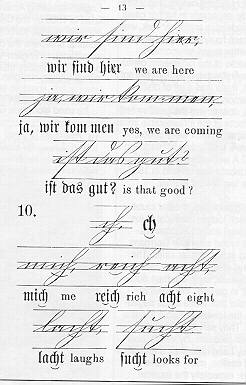
German women were less frequently employed outside the home, but the
influence of their
work on the farm was all the greater. Wife-beaters, however, were
apparently found less in
Anglo-American families than in German families. The 1868 example of Carl
Wihl, a farmer in
Indiana, also shows that it was less tolerated in America: "He beat up
his wife for every little
thing," reported his neighbor writing to Germany, "and that's not done
here; here, a wife must be
treated like a wife and not like a scrub rag like I saw in Germany so
often, that a man can do what
he wants to with his wife. He who likes to beat his wife had better stay
in Germany, it doesn't
work here, or soon he'll not have a wife anymore, that's what happened to
Carl Wihl"
[Kamphoefner, News, 139].
There is as yet no comprehensive statistical analysis concerning the
German-American's
choice of a mate . One
sample
that is perhaps not very
representative because it deals with the lives of successful business
people in Milwaukee, who
themselves or whose parents had immigrated from Germany, shows the
following results of mate
selection: From among the 16 who immigrated before 1882 and who averaged
25 years of age,
75% married a German woman. Only three married an American, three did not
get married. Of
the 32 children of German immigrants who were born in America around the
turn of the century
of German parents, or with one parent born in Germany, and who in 1920
were at the head of
their companies and married on the average at age 28, 66% married
"German" women but not
necessarily women who had been born in Germany. Only five of them married
Americans. Six
picked someone out of the melting pot and decided to marry non-Germans or
a non-American, for
that matter. Four never even took the plunge.
Studies on intermarriage
between Germans and
others on the American frontier include Hildegard Binder Johnson,
"Intermarriages Between
German Pioneers and Other Nationalities in Minnesota in 1860 and
1870,"American Journal of
Sociology, 51 (1946), 299-304, and Richard M. Bernard, The Melting
Pot and the Altar:
Marital Assimilation in Early Twentieth-Century Wisconsin
(Minneapolis: University of
Minnesota Press, 1980).


